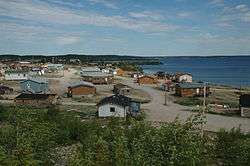Wekweeti
Wekweètì (/wɛkˈweɪti/[6]; from the Dogrib language meaning "rock lakes"), officially the Tłı̨chǫ Community Government of Wekweètì[7] is a community in the North Slave Region of the Northwest Territories, Canada. Wekweètì is a Tłı̨chǫ (Dogrib Dene) aboriginal community and is located 195 km (121 mi) north of Yellowknife. It has no year-round road access but does have a winter ice road connection; the majority of transportation to and from the community is through the Wekweètì Airport. Wekweètì is the closest community to the Ekati Diamond Mine on the border with Nunavut. Wekweètì is part of the Tlicho Government.[8]
Wekweètì | |
|---|---|
First Nation | |
 | |
Flag | |
 Wekweètì  Wekweètì | |
| Coordinates: 64°11′25″N 114°10′58″W | |
| Country | Canada |
| Territory | Northwest Territories |
| Region | North Slave |
| Constituency | Monfwi |
| Permanent community | 1962 |
| Incorporated | 4 August 2005 |
| Government | |
| • Chief | Charlie Football |
| • Community Officer | Memory Murefu |
| • MLA | Jackson Lafferty |
| Area | |
| • Land | 14.70 km2 (5.68 sq mi) |
| Elevation | 368 m (1,207 ft) |
| Population (2016)[1] | |
| • Total | 129 |
| • Density | 8.8/km2 (23/sq mi) |
| Time zone | UTC−07:00 (MST) |
| • Summer (DST) | UTC−06:00 (MDT) |
| Canadian Postal code | X0E 1W0 |
| Area code(s) | 867 |
| Telephone exchange | 713 |
| - Food price index | 144.8A |
| Sources: Department of Municipal and Community Affairs,[2] Prince of Wales Northern Heritage Centre,[3] Canada Flight Supplement[4] ^A 2015 figure based on Yellowknife = 100[5] | |
History
The area is within the traditional territory of the Tłı̨chǫ (Dogrib) First Nation and was a popular hunting camp prior to permanent settlement. In the 1960s, Dene elders around Behchokǫ̀ decided to return to the land and establish traditional camps in the bush. Wekweètì was established during this time, although in more recent years it too has become a modern community with essential services of its own. The community was formerly known as Snare Lake until 1 November 1998; prior to 4 August 2005 the community name used the spelling Wekweti.
Before 2005, the community was unincorporated, and local governance was provided by a First Nations band government, Dechi Laot'i First Nations. Under the terms of the Tłı̨chǫ Agreement, most responsibilities of Dechi Laot'i have been transferred to a new Wekweètì Community Government. However, Dechi Laot'i is still recognized by the federal government for Indian Act enrollment.
Demographics
The population was 129 according to the 2016 Census an decrease of 8.5% over the 2011 Census of 141. The majority of the population are First Nations and languages are Dogrib and English.[1] In 2017 the Government of the Northwest Territories reported that the population was 136 with an average yearly growth rate of -0.4% from 2007.[5]
| Historical population | |||||||||||||||||||||||||||||||||||||||||||||||||||||||||||||||||||||||||
|---|---|---|---|---|---|---|---|---|---|---|---|---|---|---|---|---|---|---|---|---|---|---|---|---|---|---|---|---|---|---|---|---|---|---|---|---|---|---|---|---|---|---|---|---|---|---|---|---|---|---|---|---|---|---|---|---|---|---|---|---|---|---|---|---|---|---|---|---|---|---|---|---|---|
|
| ||||||||||||||||||||||||||||||||||||||||||||||||||||||||||||||||||||||||
| Sources: NWT Bureau of Statistics (2001 - 2017)[9] | |||||||||||||||||||||||||||||||||||||||||||||||||||||||||||||||||||||||||
Services
Alexis Arrowmaker School is Wekweètì's Elementary/Junior School and was rebuilt in 1994.[10] The school is named after Alexis Arrowmaker, one of the signers of Treaty 11. The community has a store, Hozila Naedik'e General Store,[11] a ten-bed hotel/lodge, Wekweeti Hotel/Snare Lake Lodge,[12] a health centre, a community learning centre but no Royal Canadian Mounted Police detachment.[13]
Climate
| ||||||||||||||||||||||||||||||||||||||||||||||||||||||||||||||||||||||||||||||||||||||||||||||||||||||||||||||||||||||||||||
References
- "Wekweètì, Community government [Census subdivision], Northwest Territories and Northwest Territories [Territory]". 2016 Census. Statistics Canada.
- "NWT Communities - Wekweeti". Government of the Northwest Territories: Department of Municipal and Community Affairs. Retrieved 2014-01-29.
- "Northwest Territories Official Community Names and Pronunciation Guide". Prince of Wales Northern Heritage Centre. Yellowknife: Education, Culture and Employment, Government of the Northwest Territories. Archived from the original on 2016-01-13. Retrieved 2016-01-13.
- Canada Flight Supplement. Effective 0901Z 30 January 2020 to 0901Z 26 March 2020.
- Wekweètì - Statistical Profile at the GNWT
- Tłı̨chǫ Agreement (PDF), Ottawa: Queen's Printer for Canada, 2003, ISBN 0662349717
- Differences in Community Government Structures
- Wekweètì at the Tlicho Government website
- Population Estimates By Community from the GNWT
- Alexis Arrowmaker School
- Hozila Naedik'e General Store
- Wekweeti Hotel/Snare Lake Lodge
- Wekweètì Infrastructure Profile
- "NASA Earth Observations Data Set Index". NASA. Retrieved 30 January 2016.
Further reading
- Northwest Territories, and BHP Billiton Diamonds Inc. Communities and Diamonds Socio-Economic Impacts in the Communities of: Behchoko, Gameti, Whati, Wekweeti, Detah, Ndilo, Lutsel K'e, and Yellowknife : 2005 Annual Report of the Government of the Northwest Territories Under the BHP Billiton, Diavik and De Beers Socio-Economic Agreements. [Yellowknife]: Govt. of the Northwest Territories, 2006.